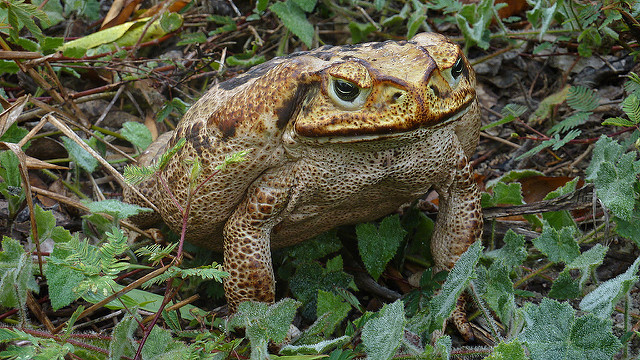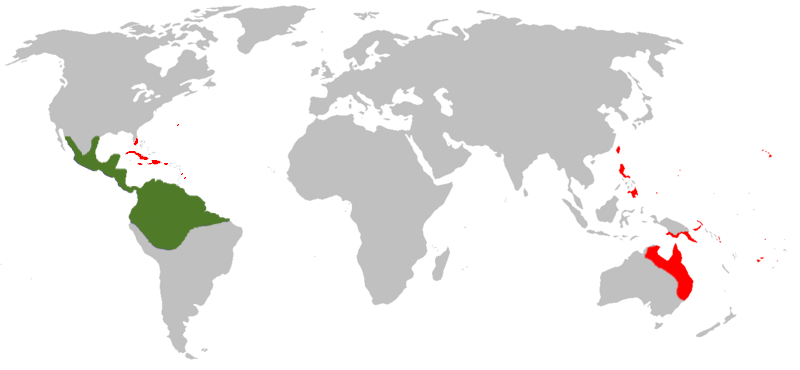Invasive Species
1.2 Cane Toad: Purposefully Introduced, but Instantly a Regret
Delia A. Randolph
A nonnative species, the cane toad (Bufo marinus), has been creating destruction to the environment of northeastern Australia. Was are the effects of a new species coming into an ecosystem? How can the effects be reversed?

The cane toad (Bufo marinus) is a type of anuran that is native to South and Central America, but was introduced to Australia in 1935 in attempt to control the population of beetles that was eating sugarcane crops.7 Humans introduced about three thousand cane toads to protect their crops, and now the population is in the hundreds of millions, which poses a dire problem for Australia.7 Although the toad is usually found in South and Central America, they are also able to live in areas both warmer, such as Australia, and cooler.10 Although the cane toad is a non-native species to Australia, they are able to thrive there due to a lack of predators that can survive their poison, and also because they will eat anything, including pet food.3 Ironically, the toads did not eat the intended problematic beetles.3
Although introduced in one area, cane toads have spread all over northeastern Australia at a rapid rate (Figure 2).5 It is calculated that the toads have spread to over a million square kilometers.8 Through radio trackers, it was discovered that the toads can travel up to 1.8 kilometers (1.2 miles) in one night, which is more than any other anuran.8 The toad is also adapting by growing longer legs which helps it travel faster and longer, leading to further spread throughout Australia.2,4,6,8,9,10 Those with longer legs are typically the first to arrive at a new location due to their faster speeds.8 When first introduced to the land, they were spreading at a rate of about 10 kilometers (6 miles) per year.3 Now, due to their individual physical growth, the toads are spreading about 60 kilometers (37 miles) per year, and have already covered a land area greater than France and Spain combined.9

When the cane toad first established itself as an invasive species, the initial concern was the threat to other animal populations. Some species, such as the goanna lizard, have had a decrease in their population because they eat the poisonous toads.9 In addition, some native snakes have been negatively affected, but most are not big enough to swallow the larger cane toad.9 Other species have learned not to eat the toad because of its toxins. There is concern that the native northern quoll (Dasyurus hallucatus) would be pushed to endangerment by the toad.1,5 The quoll is a marsupial carnivore and, like the toad, will eat nearly anything.1,5 Quolls are vulnerable because of their distinct breeding habits in which the males die after the mating season.1 There are indications that the population of the quoll is decreasing each year. Many quolls have been found dead in Kakadu National Park with reddened gums, which is a sign that they have been poisoned by eating cane toads.1 Some quolls have been taught by humans to not eat the toads through feeding them a dead toad that was not toxic, however this still made them nauseous.10 Quoll parents subsequently taught their offspring to stay away from the toad.10
Figure 3. Northern Quolls (Dasyurus hallucatus). The Northern Quoll has seen a decline in their populations in Australia due to the poisonous Cane toad. The second image shows a map of the Northern Quoll distribution in the country. Courtesy of John Gould, 1863, Wikimedia Commons. Public Domain., and IUCN Red List of Threatened Species, 2010, Wikimedia Commons. CC BY-SA 3.0.
In addition to harming animal populations via their poison, cane toads are also a threat through the taking of shelter and habitats.5 Loss of habitat is often one of the largest threats to a population, and due to the immense amount of cane toads, there has been habitat loss for native anuran.5 Another species, the rainbow bee-eater (Merops ornatus), can lose up to one third of their nesting sites each year due to cane toad invasion and predation on their eggs and young nestlings.5 There is also harm to many indigenous lizards, because the toad eats many of the insects that serve as the primary prey for lizards.1,7
Interestingly, studies of the cane toad indicate that as they grow bigger with longer legs, about 10% of the toads develop spinal arthritis.10 Toads are more likely to develop arthritis if they are faster and have longer legs.4 The skeletal system of an anuran is meant for little activity, therefore the stress on the spine is thought to cause arthritis.2 The toads are not meant to have an extremely active lifestyle, but to find more food and shelter, they have spread across Australia, causing great stress on their joints. Although this may seem beneficial to the native species of Australia, it hasn’t done much to slow the cane toad’s spread. It was discovered that toads with arthritis would only begin to slow down after about fifteen minutes of activity.2 Despite this, they traveled as far as the healthy toads because of their longer limbs.6
Although there have been many efforts and people involved, it seems nearly impossible to eradicate the toads from Australia.10 Efforts by scientists to remove eggs from ponds and kill as many cane toads as possible have been ineffective.10 A biological control that is being researched to combat cane toad populations is parasitic lungworms, but this method is not yet ready for implementation.10 Another study discovered that cane toad tadpoles like to eat cane toad eggs, because the eggs expel a toxin that attracts the tadpoles.10 Other scientists think the only hope to completely eradicate the toads would be the use of a biological control, however, this is the method that originally brought the species to Australia.3 If not stopped or controlled, the population of cane toads will have an enormous and detrimental effect on the entire Australian ecosystem.

References:
- Aldhous, P. (2004). Invasive species: The toads are coming! Nature, 432:796-798
- Brown, G.P., et al, (2007). Invasion, stress, and spinal arthritis in cane toads. Proceedings of the National Academy of Sciences of the United States of America (PNAS), 104(45):17698-17700.
- Caryl-Sue, National Geographic Society (Producer). (2011). “Cane Toads” [Film]. National Geographic. Retrieved from https://www.nationalgeographic.org/media/cane-toads/
- Cressey, D. (2007, October 15). Invading Cane Toads Suffer from Arthritis. Nature. Retrieved from http://www.nature.com/news/2007/071015/full/news.2007.165.html
- Department of the Environment, Water, Heritage and the Arts. (2010) The Cane Toad (Bufo marinus). Commonwealth of Australia. Retrieved from http://www.environment.gov.au/system/files/resources/3f534390-51d6-45b5-8411-9a3913814027/files/cane-toad-fs.pdf
- Fountain, H. (2007, October 16). Arthritis Fails to Slow Invading Toads in Australian Fields. The New York Times. Retrieved from https://nyti.ms/2kWLkp3
- National Geographic. (2016). Cane Toad. Retrieved from http://www.nationalgeographic.com/animals/amphibians/c/cane-toad/
- Phillips, B. et al. (2006). Invasion and the evolution of speed in toads. Nature, 439:803.
- Whitfield, J. (2007, March 28). Can toads keep on coming. Nature News. Retrieved from http://www.nature.com/news/2007/070326/full/news070326-7.html
- Zielinski, S. (2012). The reluctant toad killer. Science, 336(6087):1375-1377.
Figures:
- Froggydarb. (2006). [Interactive graphic of the spread of the Cane Toad throughout Australia from 1939 to 1980 at five year intervals]. Retrieved from Wikimedia Commons. CC BY-SA 3.0.
- Gould, John. (1863). [Illustration of Northern Quoll]. Modified from Wikimedia Commons. Public Domain.
- IUCN Red List of Threatened Species. (2010). [Map of the Northern Quoll range]. Retrieved from Wikimedia Commons. CC BY-SA 3.0.
- LiquidGhoul. (2006). [Map of Cane Toad Native and Introduced Ranges]. Modified from Wikimedia Commons. CC BY-SA 3.0.
- Popovkin, Alex. (2010). [Photograph of Cane Toad]. Retrieved from FlickrCommons. CC BY 2.0.
